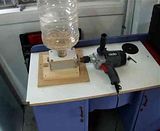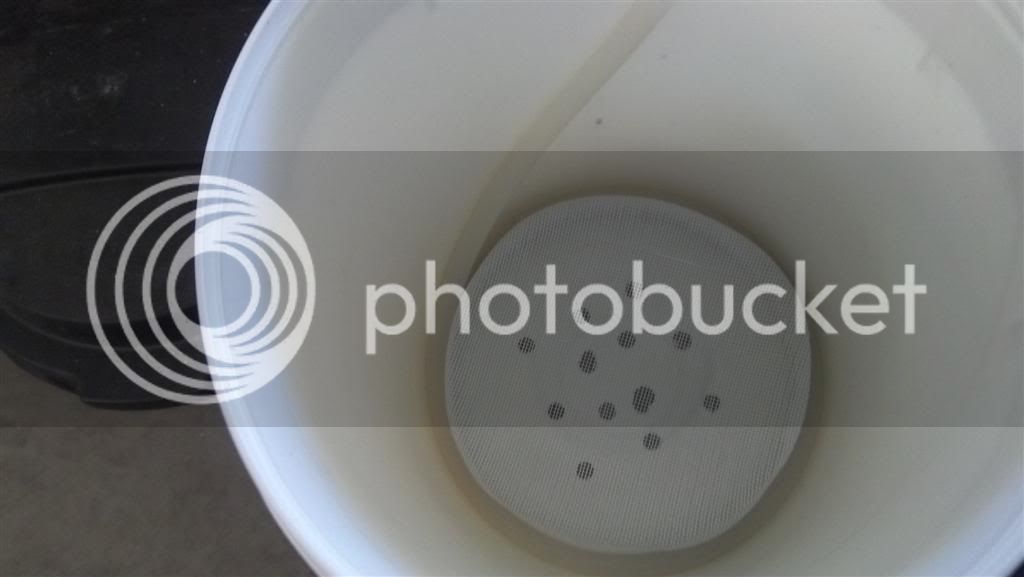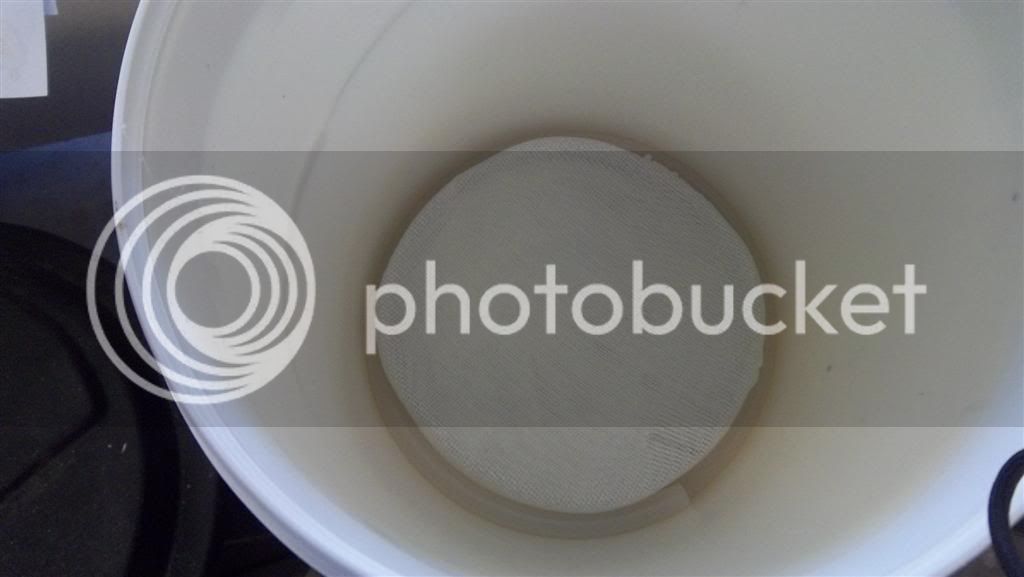mikec
Well-Known Member
- Joined
- 29/1/12
- Messages
- 784
- Reaction score
- 127
OK, in an effort to make brew day easier and avoid having to man-handle heavy, floppy, cumbersome nylon bags, I put together a "proof of concept" and did a wet run on Sunday (a simple American Ale, Fat Yak style). In a rental apartment, sky-hooks and pulleys are not an option, so I want something I can lift and then rest. Somewhat successful, with some work still to do.
I also got myself a super-dooper bling-blang Minimill, bolted it onto some timber and added the world's simplest hopper extension.
Here it is with my $30 Ozito hammer drill. This drill is no good - not enough torque low down - so I had to run the mill way too fast.
I've short-listed two Ozito replacements. A high-torque low-speed (0-550rpm) for $90 and a two-speed hammer (0-1000, 0-3000) for $80. In addition each one has a variable speed dial so I need to work out which one works best at around 200rpm. Preferably I can dial down the speed and lock the trigger on so I don't have to hold it!

The grain came out like so

The bucket. It's a bit dark but you can make out the legs. This is to raise the bucket in the pot so there is some liquid below, which will be heated first and pumped up to the top.

Inside shot of the bottom of the bucket. Big holes in the bucket, with a splatter guard sitting over them. Lined the splatter guard with silicon air hose, and it wedges quite nicely into the bottom of the bucket.

The rig - bucket sits in the 40L aluminium pot, atop a gas stove. Copper pickup tube, 1/2" all-thread, ball-valve, brown pump, silicon hose up to the top, second flow-control tap connected to some aquarium spray bars to distribute hot wort throughout the bucket.


Mash in at 52, protein rest, then turn on the the heat while recirculating.
Still need to work on this part. If I pump the liquid too quickly, the bucket fills up faster than it can drain out the bottom. If I pump too slowly, the liquid in the base of the pot gets too hot (I could turn down the heat, but it takes forever to heat up as it is). An ideal solution would be to have a second grain guard in the top of the bucket like the Braumeister does, then I could pump liquid quickly and let the liquid overflow without losing the grain.

Sacc rest at 65 for an hour. One of my problems is that there is a lot of space between the bucket and the walls of the pot. I increased my grain ratio from 3:1 to 4:1 to counter this, but I needed to go further. At the start of the sacc rest I had pumped plenty of liquid into the bucket, and left the level low in the pot. But of course by the end of the mash a lot of this had drained back into the pot, leaving me with too low a liquid:grain ratio. What I should have done is added some more 65 deg water and mashed a bit longer, but I didn't. Ultimately I think this led to lower efficiency.
Turned the heat back on an recirculated while stirring until temp reached 76.
Then lift the bucket, slide a couple of SS poles underneath for it to rest on while it drains.
Sparge by pouring 80 deg water over the top for the next 20-30 minutes. My kettle heats 1.5L to 80 deg, I did about 8 runs of this and it took about half an hour. Ima get myself a cheap little urn for this task.


Finally the sparging is complete. Meanwhile the gas stove had been on full ball, heating the wort (is it wort yet?).
Efficiency was a bit down and so my sparge water brought down the SG a bit too low (1.046 instead of 1.050). So I went for a longer boil to bring it back up.
No-chilling so the bittering hops went in at 40 mins.

Dumped a hopsack into the cube for the flavour additions, filled and squeezed out the air. Let it slowly cool a bit then put it into the ferment fridge at 18 deg ready for pitching later.
I also got myself a super-dooper bling-blang Minimill, bolted it onto some timber and added the world's simplest hopper extension.
Here it is with my $30 Ozito hammer drill. This drill is no good - not enough torque low down - so I had to run the mill way too fast.
I've short-listed two Ozito replacements. A high-torque low-speed (0-550rpm) for $90 and a two-speed hammer (0-1000, 0-3000) for $80. In addition each one has a variable speed dial so I need to work out which one works best at around 200rpm. Preferably I can dial down the speed and lock the trigger on so I don't have to hold it!

The grain came out like so

The bucket. It's a bit dark but you can make out the legs. This is to raise the bucket in the pot so there is some liquid below, which will be heated first and pumped up to the top.

Inside shot of the bottom of the bucket. Big holes in the bucket, with a splatter guard sitting over them. Lined the splatter guard with silicon air hose, and it wedges quite nicely into the bottom of the bucket.

The rig - bucket sits in the 40L aluminium pot, atop a gas stove. Copper pickup tube, 1/2" all-thread, ball-valve, brown pump, silicon hose up to the top, second flow-control tap connected to some aquarium spray bars to distribute hot wort throughout the bucket.


Mash in at 52, protein rest, then turn on the the heat while recirculating.
Still need to work on this part. If I pump the liquid too quickly, the bucket fills up faster than it can drain out the bottom. If I pump too slowly, the liquid in the base of the pot gets too hot (I could turn down the heat, but it takes forever to heat up as it is). An ideal solution would be to have a second grain guard in the top of the bucket like the Braumeister does, then I could pump liquid quickly and let the liquid overflow without losing the grain.

Sacc rest at 65 for an hour. One of my problems is that there is a lot of space between the bucket and the walls of the pot. I increased my grain ratio from 3:1 to 4:1 to counter this, but I needed to go further. At the start of the sacc rest I had pumped plenty of liquid into the bucket, and left the level low in the pot. But of course by the end of the mash a lot of this had drained back into the pot, leaving me with too low a liquid:grain ratio. What I should have done is added some more 65 deg water and mashed a bit longer, but I didn't. Ultimately I think this led to lower efficiency.
Turned the heat back on an recirculated while stirring until temp reached 76.
Then lift the bucket, slide a couple of SS poles underneath for it to rest on while it drains.
Sparge by pouring 80 deg water over the top for the next 20-30 minutes. My kettle heats 1.5L to 80 deg, I did about 8 runs of this and it took about half an hour. Ima get myself a cheap little urn for this task.


Finally the sparging is complete. Meanwhile the gas stove had been on full ball, heating the wort (is it wort yet?).
Efficiency was a bit down and so my sparge water brought down the SG a bit too low (1.046 instead of 1.050). So I went for a longer boil to bring it back up.
No-chilling so the bittering hops went in at 40 mins.

Dumped a hopsack into the cube for the flavour additions, filled and squeezed out the air. Let it slowly cool a bit then put it into the ferment fridge at 18 deg ready for pitching later.









